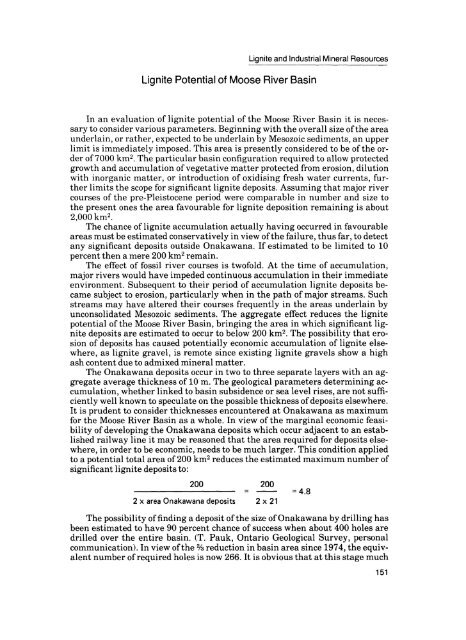Moose River Basin: geology and mineral potential - Geology Ontario
Moose River Basin: geology and mineral potential - Geology Ontario
Moose River Basin: geology and mineral potential - Geology Ontario
You also want an ePaper? Increase the reach of your titles
YUMPU automatically turns print PDFs into web optimized ePapers that Google loves.
Lignite Potential of <strong>Moose</strong> <strong>River</strong> <strong>Basin</strong><br />
Lignite <strong>and</strong> Industrial Mineral Resources<br />
In an evaluation of lignite <strong>potential</strong> of the <strong>Moose</strong> <strong>River</strong> <strong>Basin</strong> it is neces<br />
sary to consider various parameters. Beginning with the overall size of the area<br />
underlain, or rather, expected to be underlain by Mesozoic sediments, an upper<br />
limit is immediately imposed. This area is presently considered to be of the or<br />
der of 7000 km2 . The particular basin configuration required to allow protected<br />
growth <strong>and</strong> accumulation of vegetative matter protected from erosion, dilution<br />
with inorganic matter, or introduction of oxidising fresh water currents, fur<br />
ther limits the scope for significant lignite deposits. Assuming that major river<br />
courses of the pre-Pleistocene period were comparable in number <strong>and</strong> size to<br />
the present ones the area favourable for lignite deposition remaining is about<br />
2,000 km 2 .<br />
The chance of lignite accumulation actually having occurred in favourable<br />
areas must be estimated conservatively in view of the failure, thus far, to detect<br />
any significant deposits outside Onakawana. If estimated to be limited to 10<br />
percent then a mere 200 km2 remain.<br />
The effect of fossil river courses is twofold. At the time of accumulation,<br />
major rivers would have impeded continuous accumulation in their immediate<br />
environment. Subsequent to their period of accumulation lignite deposits be<br />
came subject to erosion, particularly when in the path of major streams. Such<br />
streams may have altered their courses frequently in the areas underlain by<br />
unconsolidated Mesozoic sediments. The aggregate effect reduces the lignite<br />
<strong>potential</strong> of the <strong>Moose</strong> <strong>River</strong> <strong>Basin</strong>, bringing the area in which significant lig<br />
nite deposits are estimated to occur to below 200 km2 . The possibility that ero<br />
sion of deposits has caused <strong>potential</strong>ly economic accumulation of lignite else<br />
where, as lignite gravel, is remote since existing lignite gravels show a high<br />
ash content due to admixed <strong>mineral</strong> matter.<br />
The Onakawana deposits occur in two to three separate layers with an ag<br />
gregate average thickness of 10 m. The geological parameters determining ac<br />
cumulation, whether linked to basin subsidence or sea level rises, are not suffi<br />
ciently well known to speculate on the possible thickness of deposits elsewhere.<br />
It is prudent to consider thicknesses encountered at Onakawana as maximum<br />
for the <strong>Moose</strong> <strong>River</strong> <strong>Basin</strong> as a whole. In view of the marginal economic feasi<br />
bility of developing the Onakawana deposits which occur adjacent to an estab<br />
lished railway line it may be reasoned that the area required for deposits else<br />
where, in order to be economic, needs to be much larger. This condition applied<br />
to a <strong>potential</strong> total area of 200 km2 reduces the estimated maximum number of<br />
significant lignite deposits to:<br />
200<br />
——————————————— =<br />
200<br />
——— =4.8<br />
2 x area Onakawana deposits 2x21<br />
The possibility of finding a deposit of the size of Onakawana by drilling has<br />
been estimated to have 90 percent chance of success when about 400 holes are<br />
drilled over the entire basin. (T. Pauk, <strong>Ontario</strong> Geological Survey, personal<br />
communication). In view of the ^3 reduction in basin area since 1974, the equiv<br />
alent number of required holes is now 266. It is obvious that at this stage much<br />
151

















